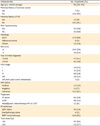1. Korea Central Cancer Registry. National Cancer Center. Annual report of cancer statistics in Korea in 2012, Ministry of Health and Welfare. Goyang: National Cancer Center;2014.
2. Rajagopalan MS, Xu KM, Lin JF, Sukumvanich P, Krivak TC, Beriwal S. Adoption and impact of concurrent chemoradiation therapy for vaginal cancer: a National Cancer Data Base (NCDB) study. Gynecol Oncol. 2014; 135:495–502.
3. Frank SJ, Jhingran A, Levenback C, Eifel PJ. Definitive radiation therapy for squamous cell carcinoma of the vagina. Int J Radiat Oncol Biol Phys. 2005; 62:138–147.
4. Tran PT, Su Z, Lee P, Lavori P, Husain A, Teng N, et al. Prognostic factors for outcomes and complications for primary squamous cell carcinoma of the vagina treated with radiation. Gynecol Oncol. 2007; 105:641–649.
5. Mock U, Kucera H, Fellner C, Knocke TH, Pötter R. High-dose-rate (HDR) brachytherapy with or without external beam radiotherapy in the treatment of primary vaginal carcinoma: long-term results and side effects. Int J Radiat Oncol Biol Phys. 2003; 56:950–957.
6. de Crevoisier R, Sanfilippo N, Gerbaulet A, Morice P, Pomel C, Castaigne D, et al. Exclusive radiotherapy for primary squamous cell carcinoma of the vagina. Radiother Oncol. 2007; 85:362–370.
7. Stuart GC, Allen HH, Anderson RJ. Squamous cell carcinoma of the vagina following hysterectomy. Am J Obstet Gynecol. 1981; 139:311–315.
8. Bell J, Sevin BU, Averette H, Nadji M. Vaginal cancer after hysterectomy for benign disease: value of cytologic screening. Obstet Gynecol. 1984; 64:699–702.
9. Daling JR, Madeleine MM, Schwartz SM, Shera KA, Carter JJ, McKnight B, et al. A population-based study of squamous cell vaginal cancer: HPV and cofactors. Gynecol Oncol. 2002; 84:263–270.
10. Chyle V, Zagars GK, Wheeler JA, Wharton JT, Delclos L. Definitive radiotherapy for carcinoma of the vagina: outcome and prognostic factors. Int J Radiat Oncol Biol Phys. 1996; 35:891–905.
11. Shah CA, Goff BA, Lowe K, Peters WA 3rd, Li CI. Factors affecting risk of mortality in women with vaginal cancer. Obstet Gynecol. 2009; 113:1038–1045.
12. Creasman WT, Phillips JL, Menck HR. The National Cancer Data Base report on cancer of the vagina. Cancer. 1998; 83:1033–1040.
13. Stock RG, Chen AS, Seski J. A 30-year experience in the management of primary carcinoma of the vagina: analysis of prognostic factors and treatment modalities. Gynecol Oncol. 1995; 56:45–52.
14. Lee LJ, Jhingran A, Kidd E, Cardenes HR, Elshaikh MA, Erickson B, et al. Acr appropriateness Criteria management of vaginal cancer. Oncology (Williston Park). 2013; 27:1166–1173.
15. Davis KP, Stanhope CR, Garton GR, Atkinson EJ, O’Brien PC. Invasive vaginal carcinoma: analysis of early-stage disease. Gynecol Oncol. 1991; 42:131–136.
16. de Jong MC, Pramana J, Knegjens JL, Balm AJ, van den Brekel MW, Hauptmann M, et al. HPV and high-risk gene expression profiles predict response to chemoradiotherapy in head and neck cancer, independent of clinical factors. Radiother Oncol. 2010; 95:365–370.
17. Walboomers JM, Jacobs MV, Manos MM, Bosch FX, Kummer JA, Shah KV, et al. Human papillomavirus is a necessary cause of invasive cervical cancer worldwide. J Pathol. 1999; 189:12–19.
18. Sinno AK, Saraiya M, Thompson TD, Hernandez BY, Goodman MT, Steinau M, et al. Human papillomavirus genotype prevalence in invasive vaginal cancer from a registry-based population. Obstet Gynecol. 2014; 123:817–821.
19. Hegemann S, Schäfer U, Lellé R, Willich N, Micke O. Long-term results of radiotherapy in primary carcinoma of the vagina. Strahlenther Onkol. 2009; 185:184–189.
20. Kanayama N, Isohashi F, Yoshioka Y, Baek S, Chatani M, Kotsuma T, et al. Definitive radiotherapy for primary vaginal cancer: correlation between treatment patterns and recurrence rate. J Radiat Res. 2015; 56:346–353.
21. Lee WR, Marcus RB Jr, Sombeck MD, Mendenhall WM, Morgan LS, Freeman DE, et al. Radiotherapy alone for carcinoma of the vagina: the importance of overall treatment time. Int J Radiat Oncol Biol Phys. 1994; 29:983–988.
22. Eddy GL, Jenrette JM, Creasman WT. Effect of radiotherapeutic technique on local control in primary vaginal carcinoma. Int J Gynecol Cancer. 1993; 3:399–404.









 PDF
PDF Citation
Citation Print
Print



 XML Download
XML Download